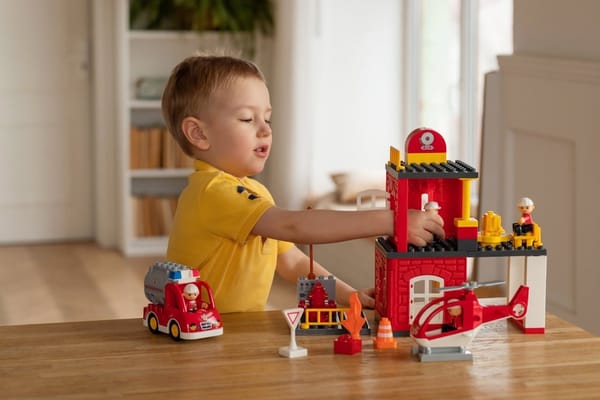How to Start Lightly Planning for Next Year—Without Overthinking It

Hey there, homeschool mama—
It’s April. You’re probably juggling end-of-year wrap-ups, trying to finish a few lingering lessons, and maybe even bracing yourself for testing or evaluations. But somewhere between those math worksheets and your third cup of coffee, your mind might be drifting toward next year.
“Maybe we’ll switch things up a little…”
“I should start researching curriculum soon.”
“What if we finally join that co-op next fall?”
And before you know it, what started as a gentle thought becomes a rabbit hole of Pinterest boards, curriculum carts, and 47 open tabs.
But here’s the truth:
You don’t need to plan everything right now.
In fact—you shouldn’t.
This is the perfect time for light planning—the kind that’s low-pressure, fun, and full of possibility. The kind that helps you slowly gather inspiration without locking yourself into anything yet.
This post will walk you through how to lightly plan for next year in a way that’s actually helpful (not overwhelming), with practical steps and a little room to dream. Let’s make this fun again, shall we?

1. Start with Gentle Reflections
Before diving into what’s next, take a quiet moment to reflect on what’s been.
Grab your favorite notebook, open a notes app, or just think through these prompts on a walk or while folding laundry:
- What felt life-giving this year?
- What subjects lit your kids up?
- What routines helped your days feel smoother?
- What felt like a struggle or consistently stressful?
- What moments made you say, “This is why we homeschool”?
You don’t need to have detailed answers. This isn’t about evaluating yourself—it’s about gathering little clues to guide next year’s choices.
Pro Tip: Don’t try to solve problems or change anything right now. Just notice what’s working and what’s not.

2. Build a “Planning Shelf” for Next Year
Ever had a brilliant idea mid-April, only to completely forget it by July?
That’s why you need a Planning Shelf—a place to gently set aside ideas, resources, and inspiration for next year. Think of it like a mental (or physical) shelf where good things can wait patiently until you’re ready to come back to them.
What might you put on your Planning Shelf?
- Curriculum you want to check out
- Read-aloud book ideas
- Unit study topics or themes
- Field trip destinations
- New routines or schedules to try
- Helpful blog posts or podcasts
You can keep your Planning Shelf in a:
- Google Doc or Trello board
- Dedicated section of your homeschool binder
- Spiral notebook or sticky note wall
- Notes app on your phone
Whatever format you choose, the goal is to take the pressure off your brain and give your ideas a home. That way, when you are ready to plan, all the gold nuggets are waiting for you.

3. Reconnect with Your “Why”
It’s tempting to jump straight into curriculum research or next year’s schedule. But before you do, take a deep breath and come back to this question:
Why are we homeschooling?
Your “why” might look different from another family’s, and that’s okay. The important thing is that you’re clear on what matters to you.
- Do you value a slower pace or nature-based learning?
- Are you homeschooling to allow more family connection?
- Is your priority flexibility, faith, or individualized education?
Write your “why” down and stick it somewhere visible. Let it guide your decisions instead of outside pressure, trends, or Instagram comparisons.

4. Let Yourself Dream a Little
Now we’re getting to the good stuff—the fun, light, imaginative part of spring planning.
You’re not choosing curriculum. You’re not finalizing anything. You’re just dreaming.
Here are two wonderful areas to dream about (without needing to commit yet):
Read-Aloud Possibilities
Read-alouds are often the heart of the homeschool day—and they’re one of the easiest things to start planning early. Make a wishlist of books you might want to read next year, like:
- Seasonal stories for fall and winter
- Historical fiction to pair with history topics
- Books tied to specific unit studies
- Audiobooks for roadschooling or rest time
Let your kids help brainstorm! Ask what kinds of stories they want more of—funny, fantasy, mysteries, adventure? Then add them to your Planning Shelf.

Field Trip Bucket List
Spring is a great time to dream about next year’s field trips. Even if you don’t book anything yet, creating a list of ideas organized by season can make planning a breeze later.
Here are a few places to spark inspiration:
- Local museums or science centers
- State or national parks
- Factory tours, fire stations, or farms
- Living history museums or reenactment events
- Performing arts (theater, orchestra, etc.)
- Outdoor seasonal experiences (apple picking, nature hikes)
Pro Tip: Field trips are often the first thing that gets forgotten once the year gets busy—but with a few notes on your Planning Shelf, you’ll have a head start.

5. Focus on One Child at a Time
Trying to plan everything for everyone all at once = stress city.
Instead, pick one child and start thinking gently about what they might need next year.
- What are their learning strengths?
- Where are they still growing?
- What are they interested in?
- Are they ready for more independence or structure?
You can even start a mini Planning Shelf for each child with notes specific to them. This child-centered approach keeps your planning manageable and focused—without the overwhelm.

6. Choose One Subject to Research (Just One!)
If you’re itching to start exploring curriculum, that’s totally okay—just don’t try to research everything right now.
Pick one subject that didn’t go so well this year (math, maybe?) and allow yourself to explore a few options. Read some reviews, download samples, or watch walk-throughs—but give yourself a time limit or a set number of resources to check.
Then? Step away. Put your notes on your Planning Shelf and revisit them when it’s time to finalize.
7. Sketch a Loose Framework (Not a Full Plan)
While you don’t need a detailed schedule in April, it can help to sketch a basic framework for next year.
Try answering:
- When will we likely start our homeschool year?
- Will we do a 4-day or 5-day week?
- Do we want to follow a term schedule or go by months?
- What subjects are non-negotiables next year?
- Are we leaning toward a theme, focus, or rhythm?
Think of this framework as scaffolding—you’ll fill in the details later, but for now, it gives you a light sense of direction.

8. Chat with Other Homeschool Moms
Planning doesn’t have to be a solo gig.
Spring is the perfect time to chat with other homeschool moms and ask:
- What are you thinking about for next year?
- Have you tried any new routines or resources you loved?
- What are you doing differently next time?
These casual conversations often spark new ideas and can make planning feel way less lonely. You might even want to host a “homeschool vision night” with friends—a cozy evening with snacks, notebooks, and lots of good chats.

9. Give Yourself Permission to Pause
Finally, a friendly reminder:
You’re still in the current homeschool year.
You do not need to plan it all now. You don’t even need to want to plan it yet.
This is simply a season of gentle noticing, soft curiosity, and setting things aside on your Planning Shelf.
Let this part of the year be light. Let it be hopeful. Let it be just enough.

Final Thoughts: Planning Can Be Peaceful
You don’t have to white-knuckle your way through homeschool planning. It can be peaceful. Slow. Kind to your nervous system. And even a little fun.
Let this be the year you:
- Reflect without rushing
- Dream without pressure
- Plan with clarity and confidence
And when the real planning begins? You’ll already have a Planning Shelf full of gold.
You’ve got this, mama.


